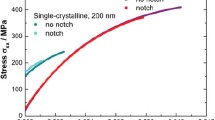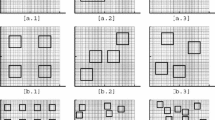Abstract
The constraint of a thin silver interlayer is used to create high triaxial stresses to evaluate the applicability of theoretical models for ductile fracture. Rice and Tracey's model for cavity expansion under high triaxial states of stress and Huanget al.'s model for cavity instability were considered. The experimentally determined σ m /σ y values suggest that further investigation of the Huanget al. theory is warranted. Microstructural analysis revealed that multiple cavities were initially present in the silver interlayers, and the number and size of the cavities increased as failure was approached. Finite element analysis and experimental results showed excellent agreement in a computational determination of cavity instability. Thus, it appears that ductile fracture in constrained thin interlayers can be explained with unstable cavity growth.
Similar content being viewed by others
References
Rice, J.R. andTracey, D.M., “On the Ductile Enlargement of Voids in Triaxial Stress Fields,”J. Mech. Phys. Solids,17,201–217 (1969).
Huang, Y., Hutchinson, J.W., andTvergaard, V., “Cavitation Instabilities in Elastic-plastic Solids,”J. Mech. Phys. Solids,39,223–241 (1991).
Tvergaard, V., Huang, Y., andHutchinson, J.W., “Cavitation Instabilities in a Power Hardening Elastic-plastic Solid,”Eur. J. Mech. Solids,11,215–231 (1992).
Tolle, M.C. andKassner, M.E., “Mechanisms of Ductile Fracture in Pure Silver Under High-triaxial Stress States,”Acta Metall. Mat.,43,287–297 (1995).
Kassner, M.E., Rosen, R.S., andHenshall, G.A., “Delayed Mechanical Failure of Silver-interlayer Diffusion Bonds,”Metall. Trans. A,21,3085–3100 (1990).
Kassner, M.E., “The Rate Dependence and Microstructure of High-purity Silver Deformed to Large Strains Between 0.16 and 0.30 T_m,”Metall. Trans. A,20,2001–2010 (1989).
Koplik, J. andNeedleman, A., “Void Growth and Coalescence in Porous Plastic Solids,”Int. J. Solids Struct.,24,835–853 (1988).
Kassner, M.E., Kennedy, T.C., andSchrems, K.K., “The Mechanism of Ductile Fracture in Constrained Thin Silver Films,”Acta Mat.,46,6445–6457 (1998).
Peralta, P., Llanes, L., Bassani, J., andLaird, C., “Deformation from Twin-boundary Stresses and the Role of Texture: Application to Fatigue,”Phil. Mag. A,70,219–232 (1994).
Roehnelt, R., Kassner, M., andKennedy, T.C., “Elastic Incompatibility Stresses Across Planar and Nonplanar Grain Boundaries Applied to Ductile Fracture Criteria Under High Triaxial Stress, Scripta Mat.,”36,605–610 (1997).
Author information
Authors and Affiliations
Rights and permissions
About this article
Cite this article
Schrems, K.K., Kassner, M.E. & Kennedy, T.C. Theoretical, experimental and computational mechanics of fracture in constrained interlayers. Experimental Mechanics 40, 307–311 (2000). https://doi.org/10.1007/BF02327504
Received:
Revised:
Issue Date:
DOI: https://doi.org/10.1007/BF02327504




